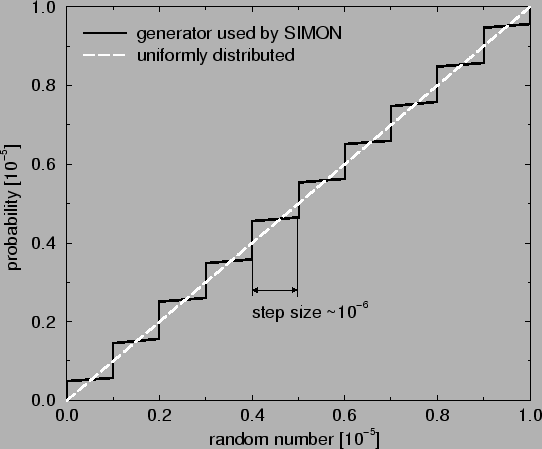



Next: 4.2.4 Accelerating the Simulator
Up: 4.2.3 Random Number Generator
Previous: 4.2.3 Random Number Generator
An ideal random number generator for uniformly distributed numbers should be
able to generate any real number
from its interval, for instance, [0,1]. However, due to the finite
precision storage of real numbers in computers, random number generators will
exhibit a finite step size in their generated numbers. The step size of a
random number generator gives the maximum length of an interval out of all
intervals in which the generator cannot generate any random number.
The multiple linear congruential method which SIMON uses has a step size of
 ,
as shown in Fig. 4.8 which
plots the probability function (4.6).
Fig. 4.8 shows only the interval [0,10-5],
however, a similar structure is found in the whole interval [0,1].
,
as shown in Fig. 4.8 which
plots the probability function (4.6).
Fig. 4.8 shows only the interval [0,10-5],
however, a similar structure is found in the whole interval [0,1].
Figure 4.8:
Resolution limit of random generators.
 |
From this step size a measure for the
resolution limit of the MC
method may
be derived. Resolution means the ratio of the tunnel rate of the rarest to the
most frequent event. Considering (3.29), we ask what is the
shortest duration between two tunnel events of the rarest process and what is
the longest duration of the most frequent tunnel process.

That means if rare and frequent tunnel events occur at the same time,
for instance one part of the circuit is in a Coulomb blockade and only the rare
co-tunneling process takes place and the other part shows normal tunneling, only
events smaller by a factor 107 as the most frequent event will
be simulated. Other events will never come out as the winner of the MC simulation, because their tunnel duration is too long. However, if the
whole circuit is in a Coulomb blockade this limitation does not apply and much rarer
events will be resolved.




Next: 4.2.4 Accelerating the Simulator
Up: 4.2.3 Random Number Generator
Previous: 4.2.3 Random Number Generator
Christoph Wasshuber

